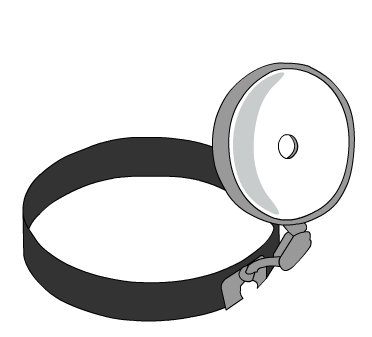1. Name of the location of 90% of epistaxis
2. A genetic disorder that forms AV malformations in the skin, lungs, brain etc
3. Name of posterior vascular plexus in the nasal cavity causing posterior epistaxis
4. 1st line treatment for all epistaxis
5. The common brand name for anterior nasal packing
6. Chemical used in cautery sticks
7. Physically scaring complication of posterior nasal packing with foleys catheter
Coming soon..
Stridor
Definition
"A high-pitched sound produced by turbulent airflow through a partially obstructed airway at the level of the supraglottis, glottis, subglottis, or trachea" Cotton, R.T. 1995
Causes
The diagram below shows the airway, its zones and the type of stridor that is caused by narrowing.

Physics of stridor
A detailed understanding of the physics beneath the symptom of stridor is beyond the remit of the course. However, for the interested, consider the diagram below. It shows a Venturi tube with air flowing through it from left to right. When the air reaches a narrowing in the tube its velocity rises and it slows once again once it is past the obstruction. This is the Venturi effect.

When gases flow faster, the pressure within them falls and there is less pressure exerted by the gas on the walls around it (Bernoulli principle). In practice, this means the airway narrows even further making the situation worse.
Another consequence of a faster moving gas is that flow becomes turbulent and turbulent flow is noisy as it induces vibration in the structures around it.
Causes of stridor
Stridor may be acute or chronic and can occur at any age. The important diseases for the Swansea course are highlighted in red.
Laryngotracheobronchitis - also called Croup
Foreign body in the larynx, trachea or bronchi
Epiglottitis
Anaphylaxis
Malignancy in the airway
Laryngomalacia
Subglottic stenosis
Laryngeal papillomata
Vocal cord paralysis
Laryngotracheobronchitis
The commonest cause of stridor in children
Affects between 6 months and 2 years - may be recurrent
Viral cause
Mild systemic upset, mild fever
Associated with a barking cough
This video clip shows a patient with croup. Note the biphasic stridor (present during both phases of breathing) and the barking cough. https://www.youtube.com/watch?v=Z1_uKqmPyLA
Foreign Body
These cause sudden symptoms in the main and the family or patient will know the exact moment when something was inhaled. It is associated with coughing or retching and the patient is distressed. Some foreign bodies present as an otherwise unexplained cough or stridor if they dont provoke dramatic initial symptoms so a FB must always be on the differential in a child with cough or stridor.
Laryngomalacia
This is a congenital condition that features short aryepiglottic folds and 'soft' laryngeal cartilages
It is the commonest congenital cause of stridor
Stridor develops shortly after birth and worsens for up to a year as the child takes greater respiratory effort
It is worse when the baby is supine
Voice is not affected and feeding is usually normal
The stridor is inspiratory - the cartilages folding inwards during inspiration and narrowing the airway
Treatment is rarely required and by a year or two the child has grown out of the problem
This video clip shows a child with inspiratory stridor. Note that he is being held on his back and that this makes the symptom more obvious. http://www.youtube.com/watch?v=W714VGeTm8Q
The second video shows an endoscopy on a child with laryngomalacia. Note the tightly curled epiglottis and the arytenoids that flop inwards during inspiration. https://www.youtube.com/watch?v=z4eM3F1f75U#t=15
Epiglottitis
This is an acute infective disease of quick onset
It strikes children between 2 and 7 years and can affect adults at any age. Historically children were more affected but Hib vaccination is reducing the frequency of disease in children.
Bacterial origin - H influenzae
Patient is toxic, flushed, and has a high fever
A sore throat is present
Children drool as swallowing is so painful
Patient prefers to sit upright
Treatment is by careful airway management and intravenous antibiotics e.g cephalosporin
Malignancy in the airway
Stridor is one of the red flags in head and neck cancer. It causes stridor by slowly enlarging and narrowing the airway, by paralysing the vocal cords or both. While growth of disease is gradual an infection or bleed can cause sudden enlargement and acute stridor.
Treating the patient is by managing the airway first and by attention to the underlying disease second.
Emergency management of stridor
The overriding principle is to manage the airway first so as to ensure adequate oxygenation and then to diagnose the cause of the problem second.
-
Quickly gather an experienced team: ENT and Anaesthetic
-
Try to keep everyone calm - anxiety will only add to the patient's distress
-
Intensive monitoring – get the patient to resus
-
High flow oxygen, preferably humidified, or Heliox
-
Adrenaline Nebulised (1ml of 1:1000 adrenaline made up to 5ml with normal saline) PRN
-
Secure good IV access if it is safe to do so (children may find this distressing)
-
High dose steroids. Nebulised budesonide for children or 8mg IV Dexamethasone for adults
-
Take a brief history if possible, probably from friends or relatives
-
Complete only a basic ENT examination, wait for senior review of the airway (keep patient in resus!). Do not examine a child's mouth by putting a tongue depressor into it!
-
Adult patients will undergo fibreoptic nasoendoscopy to visualise the airway and further management will depend on the underlying pathology
-
Children will not usually have this
-
In cases of deterioration intubation will be attempted and if this fails emergency airway access by cricothyrotomy or tracheostomy
For more information on airway management please consult the tutorial on this topic.

